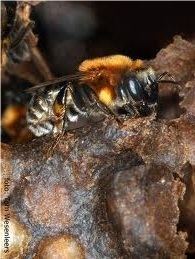Rank Species | Subfamily Apinae | |
 | ||
Similar Melipona, Melipona scutellaris, Melipona quadrifasciata, Scaptotrigona, Melipona quinquefasciata | ||
Melipona subnitida is a neotropical endemic bee species in the Apidae family found in the dry areas of Northeastern Brazil. This species of stingless bees practices single mating, monogynous habits.
Contents
- Abelha janda ra melipona subnitida
- Taxonomy and Phylogeny
- Description and identification
- Queen characteristics
- Workers
- Males
- Distribution and habitat
- Colony growth
- Colony decline
- Parasites
- Honey production
- Pollen
- History
- References
This species nests in hollow trunks of living trees, where the workers create a vertical colony. The dominance hierarchy of these perennial colonies is defined by one queen who controls her workers. Out of all of the stingless bees, M. subnitida is fairly profitable given its ability to pollinate and create honey. The field research on this species is part of the ongoing subject of Behavioral Ecology.
Abelha janda ra melipona subnitida
Taxonomy and Phylogeny
Melipona subnitida is part of the Apidae family, which consists of bumblebees, euglossines, honey bees, and stingless bees. This species is within the tribe Meliponini, and was specifically termed Melipona subnitida by Adolpho Ducke, a Brazilian researcher.
Description and identification
The Melipona subnitida species is divided into the queen, female workers, and males within each colony. They are identifiable by their obscure metasomal bands, lack of facial maculation, and fulvous thoracic pile.
Queen characteristics
The queen of the Melipona subnitida typically only mates with one male, resulting in high relatedness between female offspring of 0.75 since males are haploid so sisters are 100% related through the male line and half related through the female. The queen lays eggs and lives with her daughters, who are expected to stay with her and help her to maintain the young. The queen is identifiable by her lack of pollen carrying hairs on certain legs and she is smaller in size. Also, her abdomen becomes highly expanded, to a point it can no longer fly.
Workers
The workers of this species maintain the strongest fighting abilities, and come from larger cells than males.
Males
The males of Melipona subnitida are reared similarly to workers, although they are raised in different cell sizes. Workers of M. subnitida strongly resemble those of Melipona favosa.
Distribution and habitat
Melipona subnitida are commonly found in Northeastern Brazil where they are thought to be a main contributor of pollen and honey production. They are found specifically in the hollow trunks of living Bursera leptophloeos trees. Additionally, they have been noted in the Caatinga biomes, where the human population is reliant on their pollination and honey production for economic growth.
Colony growth
Perennial colonies of Melipona subnitida are composed of several hundred to thousand individuals. Colonies are created as brood cells in horizontal combs. New cells are formed as a new comb is formed on top of the old one, or a new comb is created from scratch. By adding combs peripherally, a vertical column of combs is created. These colonies demonstrate monogyny through their mating habits. It has also been observed that the growth of males within colonies abides by "Male-Producing Periods" in which males are produced during a specific, controlled, period of time. It is noted that both the workers and queens contribute to the offspring of the colonies, so there is a varying proportion per population of bees that are born from the queen or the workers.
Colony decline
The queen maintains her power by killing cells that may contain potential queens. Only one queen may exist in a colony at a time and she lays eggs and lives together with her daughters. It is the responsibility of the daughters to take care of brood, protect the nest, and forage for food. Other causes of colony decline are extraction of colonies for profit use, or from deforestation, thus destroying the homes of this species.
Parasites
This species has been observed to be a host for a variety of parasites such as flies, beetle mites, moths, ants, and robber stingless bees. There has specifically been noted an infestation of mantisflies of the M. subnitida colonies in Northeastern Brazil.
Honey production
Specific colonies of M. subnitida are known to produce up to 6 liters of honey per year in the Caatinga region of Brazil. This honey, called jandaíra honey, is considered quite profitable and maintains a particular taste due to the mechanism by which it is made by these bees. This species is able to help the population in this area gain a profitable industry on the condition that predatory extraction and deforestation are minimal, which is the main cause of the decline of M. subnitida.
Pollen
The pollen of M. subnitida has been discovered to contain high protein content and is extremely rich in amino acids, unlike pollen of other stingless bee species. Because of this, it is noted that the pollen of jandaíra bees, contains more than sufficient nutritional value. When compared to the bee Apis mellifera, M. subnitida has a significant advantage in its pollen, given that it contains the sugar mannitol rather than glucose and fructose.
History
Capturing or destroying existing colonies of M. subnitida is forbidden in Brazil. Artificial traps can be maintained by verified beekeepers as long as the bees form the new colonies on their own accord rather than being trapped. New colonies can be formed by division of already existing captive colonies, which can be done up to four times a year if conditions are adequate and enough food is artificially provided, avoiding the bees to expend too much effort to find food for themselves.
